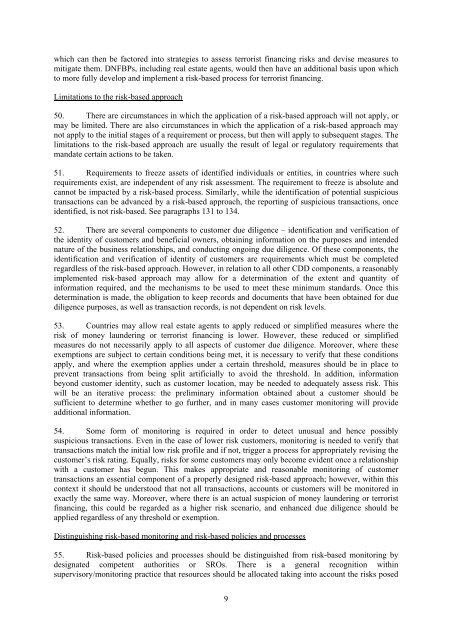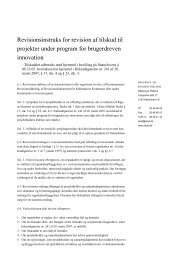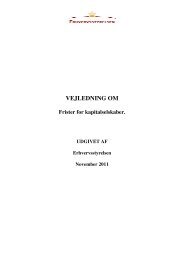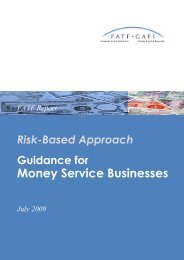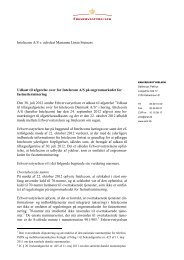RBA Guidance for Real Estate Agents.pdf - FATF
RBA Guidance for Real Estate Agents.pdf - FATF
RBA Guidance for Real Estate Agents.pdf - FATF
Create successful ePaper yourself
Turn your PDF publications into a flip-book with our unique Google optimized e-Paper software.
which can then be factored into strategies to assess terrorist financing risks and devise measures tomitigate them. DNFBPs, including real estate agents, would then have an additional basis upon whichto more fully develop and implement a risk-based process <strong>for</strong> terrorist financing.Limitations to the risk-based approach50. There are circumstances in which the application of a risk-based approach will not apply, ormay be limited. There are also circumstances in which the application of a risk-based approach maynot apply to the initial stages of a requirement or process, but then will apply to subsequent stages. Thelimitations to the risk-based approach are usually the result of legal or regulatory requirements thatmandate certain actions to be taken.51. Requirements to freeze assets of identified individuals or entities, in countries where suchrequirements exist, are independent of any risk assessment. The requirement to freeze is absolute andcannot be impacted by a risk-based process. Similarly, while the identification of potential suspicioustransactions can be advanced by a risk-based approach, the reporting of suspicious transactions, onceidentified, is not risk-based. See paragraphs 131 to 134.52. There are several components to customer due diligence – identification and verification ofthe identity of customers and beneficial owners, obtaining in<strong>for</strong>mation on the purposes and intendednature of the business relationships, and conducting ongoing due diligence. Of these components, theidentification and verification of identity of customers are requirements which must be completedregardless of the risk-based approach. However, in relation to all other CDD components, a reasonablyimplemented risk-based approach may allow <strong>for</strong> a determination of the extent and quantity ofin<strong>for</strong>mation required, and the mechanisms to be used to meet these minimum standards. Once thisdetermination is made, the obligation to keep records and documents that have been obtained <strong>for</strong> duediligence purposes, as well as transaction records, is not dependent on risk levels.53. Countries may allow real estate agents to apply reduced or simplified measures where therisk of money laundering or terrorist financing is lower. However, these reduced or simplifiedmeasures do not necessarily apply to all aspects of customer due diligence. Moreover, where theseexemptions are subject to certain conditions being met, it is necessary to verify that these conditionsapply, and where the exemption applies under a certain threshold, measures should be in place toprevent transactions from being split artificially to avoid the threshold. In addition, in<strong>for</strong>mationbeyond customer identity, such as customer location, may be needed to adequately assess risk. Thiswill be an iterative process: the preliminary in<strong>for</strong>mation obtained about a customer should besufficient to determine whether to go further, and in many cases customer monitoring will provideadditional in<strong>for</strong>mation.54. Some <strong>for</strong>m of monitoring is required in order to detect unusual and hence possiblysuspicious transactions. Even in the case of lower risk customers, monitoring is needed to verify thattransactions match the initial low risk profile and if not, trigger a process <strong>for</strong> appropriately revising thecustomer’s risk rating. Equally, risks <strong>for</strong> some customers may only become evident once a relationshipwith a customer has begun. This makes appropriate and reasonable monitoring of customertransactions an essential component of a properly designed risk-based approach; however, within thiscontext it should be understood that not all transactions, accounts or customers will be monitored inexactly the same way. Moreover, where there is an actual suspicion of money laundering or terroristfinancing, this could be regarded as a higher risk scenario, and enhanced due diligence should beapplied regardless of any threshold or exemption.Distinguishing risk-based monitoring and risk-based policies and processes55. Risk-based policies and processes should be distinguished from risk-based monitoring bydesignated competent authorities or SROs. There is a general recognition withinsupervisory/monitoring practice that resources should be allocated taking into account the risks posed9


